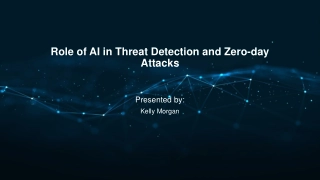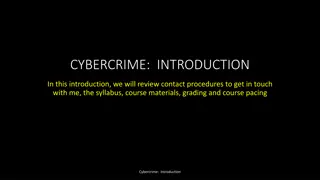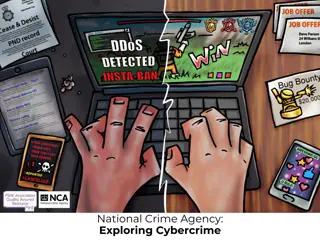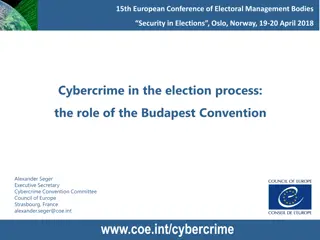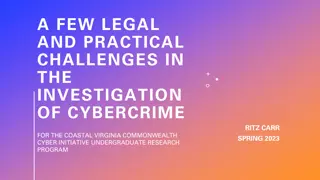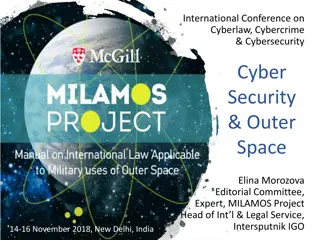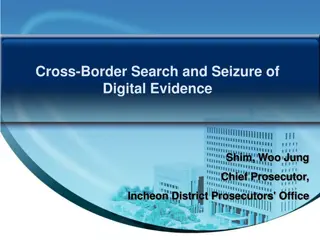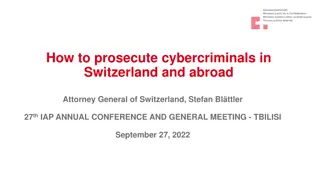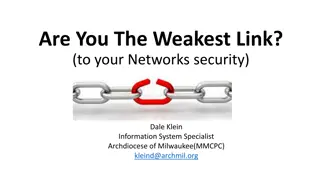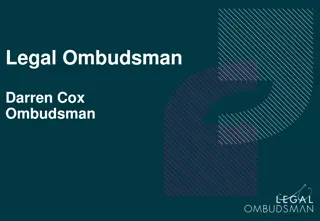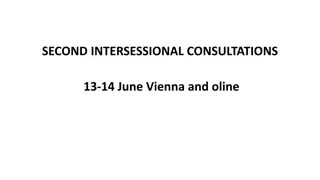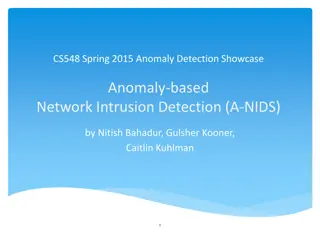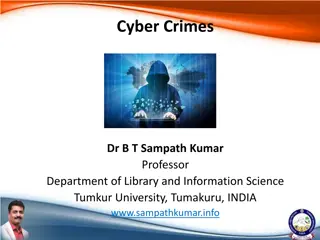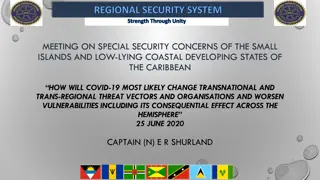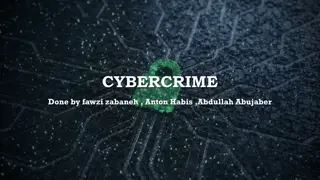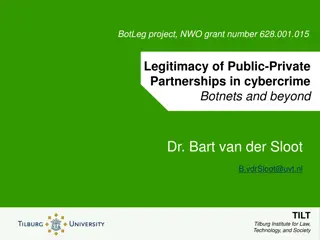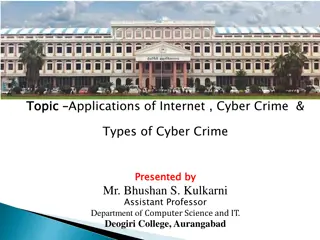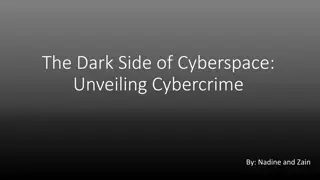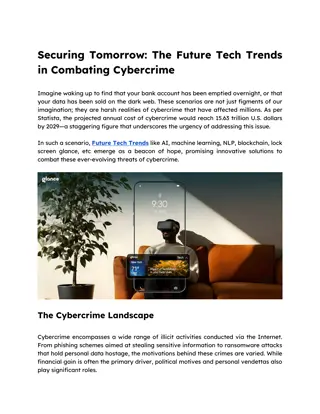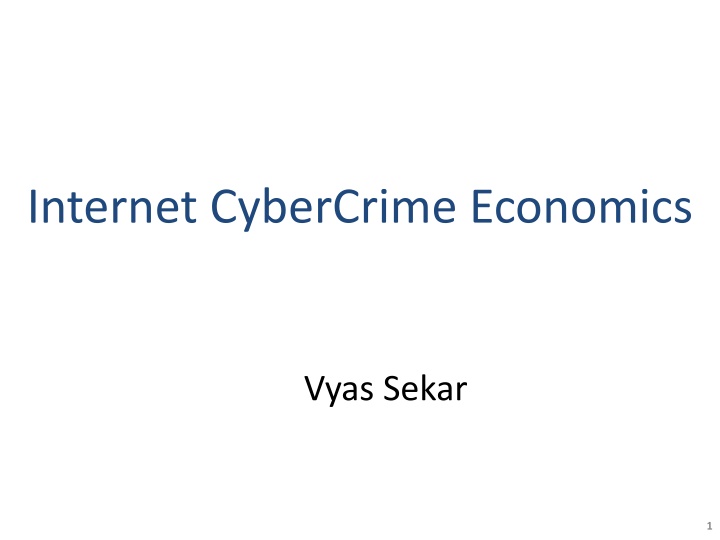
Internet Cybercrime Economics
Explore the intricate world of internet cybercrime economics through the lens of studying attack ecosystems, potential vulnerabilities, organizations involved, ease of prevention, and attackers' ability to adapt and revive. Delve into the challenges of researching this topic, including sensitivity and investigative complexities, with insights from published works and practical findings on spam, affiliate networks, and more.
Download Presentation

Please find below an Image/Link to download the presentation.
The content on the website is provided AS IS for your information and personal use only. It may not be sold, licensed, or shared on other websites without obtaining consent from the author. If you encounter any issues during the download, it is possible that the publisher has removed the file from their server.
You are allowed to download the files provided on this website for personal or commercial use, subject to the condition that they are used lawfully. All files are the property of their respective owners.
The content on the website is provided AS IS for your information and personal use only. It may not be sold, licensed, or shared on other websites without obtaining consent from the author.
E N D
Presentation Transcript
Internet CyberCrime Economics Vyas Sekar 1
Why study Internet cybercrime? Understand structure of attack ecosystem Potential weaknesses? How many organizations involved? How easy is to stop? How easy is it for attackers to respawn? 2
Hard to see published work on this topic Sensitive Hard to perform this style of investigation Ground truth E.g., check out krebsonsecurity.com UCSD/ICSI have done quite a bit 3
Two papers Click Trajectories Manufacturing Compromise 4
Click Trajectory Characterize resource dependencies for spam Many months of spam data Analyze ecosystem of servers, name servers, hosts Real online transactions! 5
Key findings from paper Payment tier is most concentrated Few banks seem to transact most payments Potential point of effective blocking! 6
Spam is a complex business today Advertising Sending emails ec Click support Non trivial and need to be robust to defenders Realization Get actual transactions customer support 7
Prior work on Spam Detection ML/NLP etc Blocking signatures, network blocks Mostly focus on the advertising aspect This work is different focus on Click and realization aspects 8
Click support in depth Historical: direct urls Easy to block Currently use many redirects Outsourced DNS Managed DNS Domain resources eventually managed by spammer Find indifferent registrars Name servers Find bulletproof hosting services Web servers Bulletproof hosting, fast flux DNS 9
Emergence of affiliates Before Spammer does everything from sending to hosting and payment etc Now Find a way to spam Join affiliate Affiliate Handles logistics and pays commission to spammer Provides storefront/web templates etc Specialization of market! 10
Realization step Use conventional payment step like paypal/credit card etc Three parts: Issuing bank, acquiring bank, association network (visa,mastercard) To be viable have to be part of association network and abide by their rules Get product from somewhere and ship B2B sites 11
Curiously.. Most transactions are coded with correct transaction codes Visa/Mastercard are quite severe on violations! 12
Feed collection from multiple sources E.g, honeypots, bots, third parties Extract URLs that point to spam Build custom DNS and web crawlers to extract nameservers and hosting servers E.g., take screenshots, emulate JS/flash etc Some optimizations for scalability to reduce redundant crawls etc 15
Content clustering to get high-level business activites Pharma, Replicas, Software Cluster pages that look similar and tag categories Cluster by affiliates also Manual reg exp tagging 17
Purchasing Did 120 purchases Some were blocked! 76 authorized and 56 settled 18
Doing this study is non-trivial! Spammers are not dumb! Care to ensure IP was correct Spammers check for security companies trying to catch them and use GeoLoc services Tracking transactions is not easy Paying from grants is not easy Got a bank to give them throwaway cards and track transactions Ethics/Legality What products to buy? Human subjects? 19
Why take all this pain?? Analyze bottlenecks in spam value chain! Name servers? Hosting servers? Realization? 20
Criteria for blocking Resource diversity Switching cost Few opportunities for spammers to respawn 21
Name registrars Some concentration (NauNet) But lots of diversity Low switching cost Domains are cheap and expendable bulk price: $1 22
Hosting? Many choices Low switching cost Host via botnets 23
Banks? Low diversity Three banks cover 95% of our corpus Few banks willing to work with high risk merchants High switching cost Requires creating merchant account at bank in person Money held by bank to cover chargebacks 24
Two papers Click Trajectories Manufacturing Compromise 26
Problem they are studying Emergence of software-as-a-service model in browser compromise Exploit as a service! Decoupling complexity of compromise from the act of driving traffic to the malicious server 27
Before EaaS Pay per install Malware compromises host by social engg, spam etc Hosts shared on underground forums EaaS focuses on drive by downloads 28
Whats a drive by download? download that happens withouta users knowledge E.g., innocent click on popup window or message is implicit ack for downloading Target browser and extension vulnerabilities 29
Exploit Kit Earliest known was MPACK 2006 Profiles browser/OS etc Delivers a suitable exploit Traditional: one-time fees like software New model: SaaS paradigm 31
Traffic PPI Evolution of PPI Decouple the steps PPI Service handles 1,2,3 and 5 Client just provides (4) 32
What happens after install? Monetization via Spam PII harvesting Click fraud Hijacking browser FakeAV Proxy and hosting ( cloud ) Droppers for third parties 33
Contained execution Typical of honeypots Want to fake real services so that malware behaves normally But avoid damage to real services E.g., Trap on actual packets 36
Clustering malware families Several heuristics Domains contacted HTTP requests System modifications Screenshots 37
Key findings No single source of malware is comprehensive 9 exploit kits account for 92% of malicious URLS 29% are Blackhole Kits distribute 32 most prominent malware families Infrastructure for hosting is short lived 2.5 hrs URL crawling has limitations 38
Takeaways Cybercrime infrastructure is a full-fledged business Pretty robust ecosystem Often hide behind bulletproof hosting services and/or botnets Emergence of business models Affiliates, EaaS, Exploit kits, specialization , globalization , customer care Payment seems like a potential bottleneck 39

